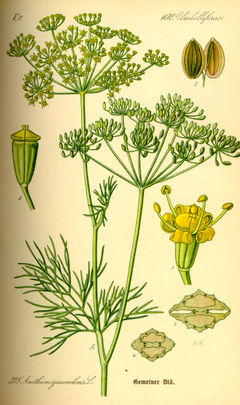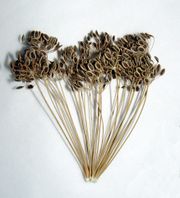Dill
2008/9 Schools Wikipedia Selection. Related subjects: Plants
| Dill | ||||||||||||||
|---|---|---|---|---|---|---|---|---|---|---|---|---|---|---|
 |
||||||||||||||
| Scientific classification | ||||||||||||||
|
||||||||||||||
| Binomial name | ||||||||||||||
| Anethum graveolens L. |
Dill (Anethum graveolens) is a short-lived annual herb. It is the sole species of the genus Anethum, though classified by some botanists in a related genus as Peucedanum graveolens (L.) C.B.Clarke.
It grows to 40-60 cm tall, with slender stems and alternate, finely divided, softly delicate leaves 10-20 cm long. The ultimate leaf divisions are 1-2 mm broad, slightly broader than the similar leaves of fennel, which are threadlike, less than 1 mm broad, but harder in texture. The flowers are white to yellow, in small umbels 2-9 cm diameter. The seeds are 4-5 mm long and 1 mm thick, and straight to slightly curved with a longitudinally ridged surface.
Its seeds, dill seed are used as a spice, and its fresh leaves, dill, and its dried leaves, dill weed, are used as herbs.
Origins and history
Dill originated in central Asia. Zohary and Hopf remark that "wild and weedy types of dill are widespread in the Mediterranean basin and in West Asia."
Although several twigs of dill were found in the tomb of Amenhotep II, they report that the earliest archeological evidence for its cultivation comes from late Neolithic lake shore settlements in Switzerland. Traces have been found in Roman ruins in Great Britain.
In Semitic languages it is known by the name of Shubit. The Talmud requires that tithes shall be paid on the seeds, leaves, and stem of dill. The Bible states that the Pharisees were in the habit of paying dill as tithe (Matthew 23:23) ; Jesus Christ is said to have rebuked them for tithing dill but omitting mercy.
Name
The name dill is thought to have originated from a Norse or Anglo-Saxon word 'dylle' meaning to soothe or lull, the plant having the carminative property of relieving gas.
In some English speaking countries, it is sometimes called Dillby. In some Asian local languages it is called as "Shepu" or "Sowa".
Uses
Fresh and dried dill leaves (sometimes called "dill weed" to distinguish it from dill seed) are used as herbs.
Like caraway, its fernlike leaves are aromatic, and are used to flavor many foods, such as gravlax (cured salmon), borscht and other soups, and pickles (where sometimes the dill flower is used). Dill is said to be best when used fresh, as it loses its flavor rapidly if dried; however, freeze-dried dill leaves preserve their flavor relatively well for a few months.
In the Middle Ages, dill was thought to protect against witchcraft.
Dill seed is used as a spice, with a flavor similar to caraway.
Dill oil can be extracted from the leaves, stems and seeds of the plant.
Dill can also be used to help cure both insomnia and bad breath. Sometimes dill is made into a tea to help cure an upset stomach.
Culture
One Serbian proverb states: "On je u svakoj čorbi mirođija" ("He is dill in every broth") meaning "He is present everywhere you go" or "He is involved in every affair you hear about"
http://www.serbiatouristguide.com/live/O_Srbiji/Narodne_umotvorine
Cultivation
Successful cultivation requires warm to hot summers with high sunshine levels; even partial shade will reduce the yield substantially. It also prefers rich, well drained soil. The seeds are viable for 3-10 years. Plants intended for seed for further planting should not be grown near fennel, as the two species can hybridise.
The seed is harvested by cutting the flower heads off the stalks when the seed is beginning to ripen. The seed heads are placed upside down in a paper bag and left in a warm dry place for a week. The seeds then separate from the stems easily for storage in an airtight container.
